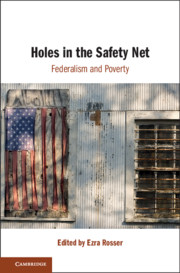Book contents
- Holes in the Safety Net
- Holes in the Safety Net
- Copyright page
- Dedication
- Contents
- Contributors
- Acknowledgments
- Introduction
- Part I Welfare and Federalism
- Part II States, Federalism, and Antipoverty Efforts
- 4 States’ Rights and State Wrongs
- 5 State and Local Tax Takeaways
- 6 Early Childhood Development and the Replication of Poverty
- 7 States Diverting Funds from the Poor
- 8 States’ Evolving Role in the Supplemental Nutritional Assistance Program
- Part III Advocacy
- Index
4 - States’ Rights and State Wrongs
Supplemental Nutritional Assistance Program Work Requirements in Rural America
from Part II - States, Federalism, and Antipoverty Efforts
Published online by Cambridge University Press: 05 September 2019
- Holes in the Safety Net
- Holes in the Safety Net
- Copyright page
- Dedication
- Contents
- Contributors
- Acknowledgments
- Introduction
- Part I Welfare and Federalism
- Part II States, Federalism, and Antipoverty Efforts
- 4 States’ Rights and State Wrongs
- 5 State and Local Tax Takeaways
- 6 Early Childhood Development and the Replication of Poverty
- 7 States Diverting Funds from the Poor
- 8 States’ Evolving Role in the Supplemental Nutritional Assistance Program
- Part III Advocacy
- Index
Summary
A resurgence in work requirements for safety-net programs, including the Supplemental Nutrition Assistance Program (SNAP), has marked the early years of the Trump administration. Some lawmakers at both the federal and state level have moved to revive and expand SNAP’s work requirements, despite evidence that such work requirements do little to increase self-sufficiency or improve long-term economic outcomes among those living in poverty.This chapter takes up the issue of work requirements in the context of rural communities, where the need for safety-net programs and food system supports is acute. We begin with a brief overview of SNAP and examine the recent push to make SNAP work requirements more strict.We then turn to an overview of the need and current state of use of the social safety net in rural America. If work requirements are to be effective – and, indeed, appropriate – work opportunities must be available.We, therefore, consider employment data and information on safety-net use across the rural-urban axis. Finally, we present a case study about the results of relatively early efforts to impose work requirements on SNAP receipt in Maine.
- Type
- Chapter
- Information
- Holes in the Safety NetFederalism and Poverty, pp. 91 - 109Publisher: Cambridge University PressPrint publication year: 2019
- 2
- Cited by



